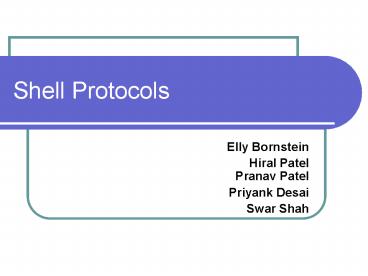Shell Protocols - PowerPoint PPT Presentation
1 / 17
Title: Shell Protocols
1
Shell Protocols
- Elly Bornstein
- Hiral PatelPranav Patel
- Priyank Desai
- Swar Shah
2
Agenda
- Introduction
- R Utilities
- Secure Shell Protocol
- Architecture of SSH
- How SSH works
- Features and Advantages
- Limitations
- Security Concerns
- Tools
- Conclusion
3
Introduction
- What is Shell?
- What are Shell Protocols?
- R Utilities
4
R Utilities
- Rlogin - allows users to log in remotely
- Rcp - provides remote file transfer.
- Rsh - executes a remote command through the rshd
daemon - Rexec - executes a remote command through the
rexecd daemon - R Utilities Security Concerns
5
Secure Shell Protocol (SSH)
- What is SSH?
- Why SSH?
- Different versions of SSH
- SSH-1
- SSH-2
6
Secure Shell Architecture
- Where does SSH lie in the protocol
- hierarchy?
- Figure Secure Shell operates at the application
layer of the TCP/IP stack, - Source www.ssh.com
7
Secure Shell - Architecture
- SSH Architecture consists of 3 components
- The Transport Layer Protocol SSH-TRANS
- The User Authentication Protocol
- SSH-USERAUTH
- The Connection Protocol SSH-CONNECT
- The complete view of SSH Architecture arch.doc
8
SSH Layers
- SSH-TRANS
- Server Authentication
- Each Server must have a Host Key
- Client must have prior knowledge of host keys
local database, trusted certification authority - Danger Man in the middle attack
- Confidentiality
- Integrity
- Key-Exchange
- Compression optional
9
SSH Layers contd.
- SSH-USERAUTH
- Authenticates Client-Side User
- Authentication Methods
- 1. Password-Based Authentication
- 2. Public-Key Based Authentication
- 3. Host-Based Authentication
- 4. GSSAPI Authentication Methods
10
SSH Layers contd.
- SSH-CONN
- Multiplexes Encrypted Channel into several
logical channels - Provides services such as
- Multiple interactive and non-interactive
sessions - Managing X, Port and Agent forwarding
- Terminal handling
- Remote program execution
11
How SSH works?
- Host Identification
- Encryption
- User Authentication
- Access to desired services
- Relate back to arch.doc
12
Features and Advantages
- SSH and SFTP for secure file transfer
- SSH and SCP for alternative to RCP
- Port forwarding and Tunneling
- Support terminal protocols for remote
administration - Secure proxy connection for Internet browsing
- Authentication methods Kerberos, SecureID, RSA,
etc.
13
Limitations
- Port ranges cant be forwarded
- Poor performance on older computers
- Graphical applications can be started, but cannot
be seen - Child processes are not killed when the user logs
out
14
Security Concerns
- Man-in-the-middle attack
- Denial of Service
- Message replay attack
- Data integrity
15
Tools
- Multi-platform
- PuTTy
- Conch
- Windows
- SecureCRT
- WinSCP
- Unix-like OS
- LSH
- OpenSSH
16
Conclusion
- Provides secure data transfer across the network
- Provides the space for extensibility and options
for using different algorithms - Most of the limitations and probable threats can
be avoided by using proper algorithms and
policies
17
Thank You































